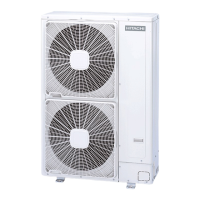Procedure
(3) &KHFNIRUDQ\JDVOHDNDJHDWWKHÀDUHQXW
connections or blazed parts by using a
foaming agent or gas leak detector.
Recommended Forming Agent Manufacturer
*XSURÀH[Yokogawa & CO.,Ltd
(4) Insulate the gas piping side and the liquid
piping side.
(5) :UDSWKHLQVXODWLRQDWHDFKÀDUHQXW
connection and wind a tape for insulation.
Be sure to use Nitrogen Gas for air-tight test.
If other gases such as oxygen gas, acetylene
JDVRUÀXRURFDUERQJDVDUHDFFLGHQWDOO\XVHG
it may cause explosion or gas intoxication.
9.2 Vacuum Pump and Refrigerant Charge
(1) Connect a manifold gauge to the check joints
at the both sides.
Continue the vacuum pumping work until the
pressure reaches -0.1MPa (-756mmHg) or
lower for one to two hours.
After the vacuum pumping work, stop the
manifold valve’s valve, stop the vacuum
pump and leave it for one hour. Check to
ensure that the pressure in the manifold
gauge does not increase. In addition,
tighten securely the cap for the check joint
according to the following tightening torque.
Gas Stop Valve: 9.0 to 14.0 N-m
Liquid Stop Valve: 14.0 to 18.0 N-m
NOTES:
1. Use tools or measuring instruments
H[FOXVLYHIRUWKHUHIULJHUDQW5$
2. If vacuum degree of -0.1MPa (-756mmHg)
is not available, it is considered that
OHDNDJHRUPRLVWXUHH[LVWV
Check for any gas leakage once again.
,IQROHDNDJHH[LVWVRSHUDWHWKHYDFXXP
pump for one to two hours. If moisture
remains inside the piping, it may cause a
compressor malfunction.
(2) This system is not necessary to charge
refrigerant less than 30m of the actual piping
length. If the total piping length is more than
30m, it is necessary additional refrigerant
charge.
(3) Changing Work
After vacuum pumping work, check that
the gas stop valve and the liquid stop valve
are fully closed. Charge the additional
refrigerant (refer to item 9.3) from the check
joint of the liquid stop valve (Charging
Refrigerant Amount Tolerance: 0.5kg).
,IWKHVSHFL¿HGUHIULJHUDQWTXDQWLW\FDQQRW
be charged, follow the procedure below.
(a) Fully open the stop valve for the gas line.
(b) Operate the compressor at the cooling
mode and add the refrigerant from the
check joint of the liquid stop valve.
At this time, the liquid stop valve is slightly
opened (Charging Refrigerant Amount
Tolerance: 0.5kg).
(c) After the refrigerant is charged, fully open
the liquid stop valve and the gas stop
valve.
(2) Connect the manifold gauge using charging
hoses with a vacuum pump or a nitrogen
cylinder to the check joints of the liquid line
and the gas line stop valves. Perform the
air-tight test. Do not open the stop valves.
Apply nitrogen gas pressure of 4.15MPa.
Do NOT use a household detergent as forming
agent which the components is not clear.
O
Tightening Torque of Stop Valves
(N-m)
Outdoor Unit
Spindle Valve
Gas Liquid
3HP
9-11 7-9
4-7HP
7-9

